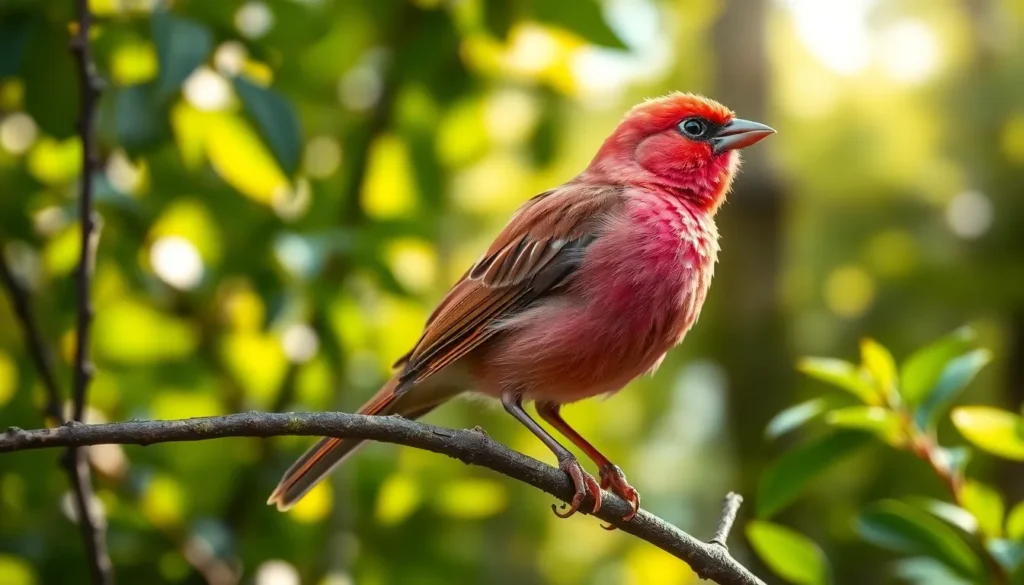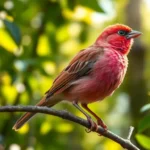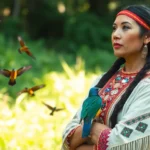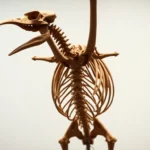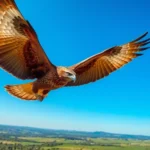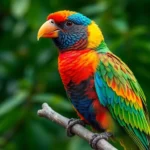We’ve all witnessed the magic of colorful birds gracing our backyards but few species captivate birdwatchers quite like the stunning rosefinch. These remarkable birds with their vibrant pink and red plumage have become increasingly popular among nature enthusiasts and photographers who seek to capture their breathtaking beauty.
Rosefinches belong to a diverse family of songbirds that spans across continents from Europe to Asia and North America. What makes these birds truly special isn’t just their striking appearance – it’s their fascinating behaviors adaptability and the crucial role they play in our ecosystems. Whether you’re spotting the Common Rosefinch in European woodlands or the Purple Finch in North American forests these birds offer endless opportunities for observation and appreciation.
We’re about to dive deep into the industry of rosefinches exploring everything from their distinctive characteristics and habitat preferences to their feeding habits and conservation status. Let’s discover what makes these pink-hued beauties such treasured members of the avian community.
What Is a Rosefinch Bird?
Rosefinches belong to the finch family Fringillidae and represent one of nature’s most colorful songbird groups. These medium-sized birds typically measure 5-7 inches in length and showcase distinctive pink to deep red plumage that makes them instantly recognizable among bird enthusiasts.
The genus Carpodacus encompasses most rosefinch species, with approximately 28 different types found across various continents. Males display the characteristic rosy-pink coloration that gives these birds their common name, while females typically exhibit more subdued brown and streaked patterns for camouflage during nesting seasons.
Rosefinch birds demonstrate remarkable geographic diversity, inhabiting regions from the Arctic tundra to temperate forests across Europe, Asia, and North America. Common rosefinch (Erythrina erythrinus) serves as the most widespread species, breeding throughout northern Eurasia and migrating to warmer climates during winter months.
| Rosefinch Characteristic | Details |
|---|---|
| Size Range | 5-7 inches (13-18 cm) |
| Weight | 0.7-1.4 ounces (20-40 grams) |
| Wingspan | 8-10 inches (20-25 cm) |
| Genus | Primarily Carpodacus |
| Total Species | Approximately 28 |
| Lifespan | 5-8 years in wild |
Physical features of rosefinch birds include sturdy, cone-shaped beaks perfectly adapted for cracking seeds and extracting nutrients from various plant materials. Their compact bodies feature strong legs for perching on branches and short, notched tails that aid in flight maneuverability through dense vegetation.
Behavioral patterns reveal rosefinch birds as social creatures that often form flocks during migration and winter feeding periods. These birds communicate through melodic songs and calls, with males performing elaborate courtship displays featuring their vibrant plumage to attract potential mates during breeding seasons.
Physical Characteristics and Identification
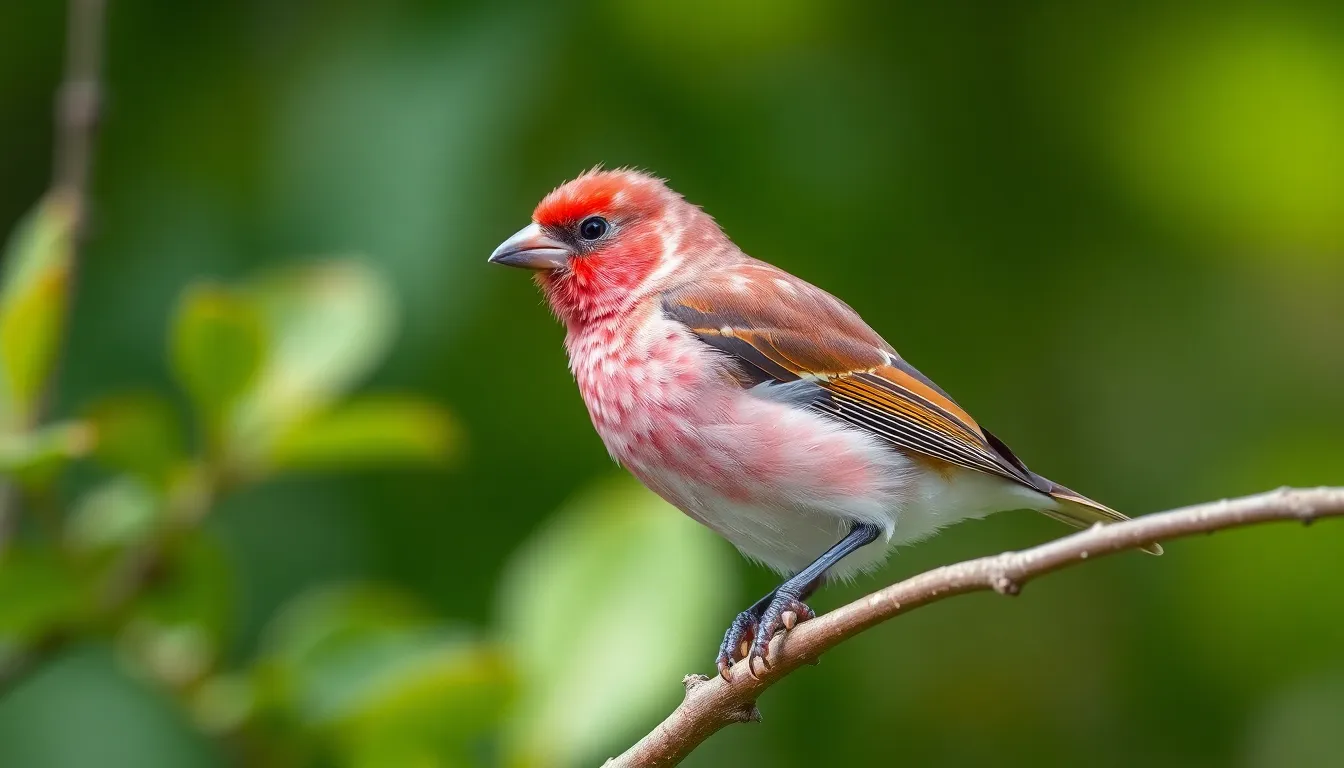
Rosefinch identification relies on recognizing distinctive plumage patterns and body features that vary significantly between males and females. We can distinguish these remarkable birds through careful observation of their coloration, size, and unique anatomical traits.
Male vs Female Appearance
Males showcase vibrant rosy-pink or red coloration across their heads, breasts, and backs during breeding season. The intensity of their pink hues indicates age and health status, with older males displaying deeper, more saturated colors. Breeding males often exhibit bright crimson caps and rose-colored rumps that make them easily identifiable in the field.
Females present muted brown and gray plumage with subtle streaking patterns across their bodies. Their earth-tone coloration provides essential camouflage during nesting periods when they incubate eggs. Female rosefinches display pale buff or whitish underparts with fine dark streaking that helps distinguish them from similar finch species.
Juvenile birds resemble females in their subdued coloring until males develop their characteristic pink plumage during their first breeding season. Non-breeding males lose much of their vibrant coloration and appear more similar to females during winter months.
Size and Build
Rosefinches measure between 5-7 inches in length with compact, sturdy builds typical of seed-eating finches. Their body weight ranges from 0.7-1.2 ounces depending on the species and seasonal conditions. Common rosefinches represent the larger end of this size range at approximately 6.5 inches.
Wingspan extends 8-10 inches across most rosefinch species, providing efficient flight capabilities for their nomadic lifestyle. Their proportionally large heads accommodate powerful jaw muscles necessary for cracking tough seed hulls. Body structure reflects their arboreal nature with strong breast muscles for sustained flight between feeding areas.
Distinctive Features
Rosefinch beaks display the characteristic cone shape of granivorous birds, measuring thick and sturdy for processing various seed types. Beak coloration varies from pale yellow to dark horn depending on species and season. Upper mandibles curve slightly downward to create optimal leverage for seed cracking.
Leg structure features strong, grasping feet with sharp claws adapted for perching on thin branches and stems. Their tarsi (lower leg segments) show dark coloration in most species with scaled texture for enhanced grip. Eye coloration ranges from dark brown to black with prominent white eye-rings in certain species.
Tail length remains relatively short compared to body size, typically measuring 2-2.5 inches with slightly forked tips. Wing bars appear as pale stripes across darker flight feathers, creating distinctive patterns visible during flight. Rump patches often contrast with back coloration, particularly noticeable in flying birds viewed from below.
Rosefinch Species and Varieties
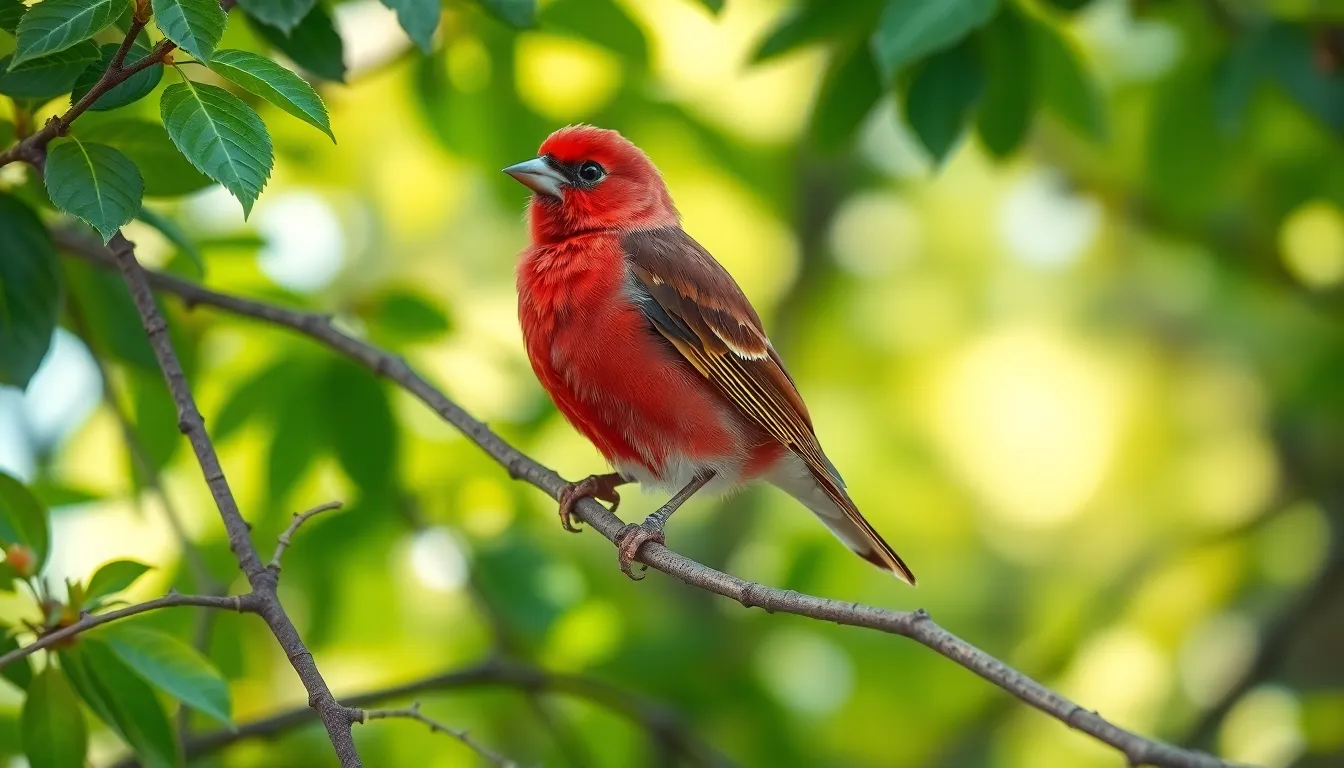
We’ve discovered that rosefinch species showcase remarkable diversity across their global range. Three primary species dominate birdwatching conversations and scientific studies worldwide.
Common Rosefinch
Common rosefinches (Erythrina erythrina) represent the most widespread species within the rosefinch family. Males display brilliant crimson red plumage across their head, breast, and rump during breeding season while maintaining brown wings and tail feathers. Females exhibit streaked brown coloration with subtle pink tinges on their rumps and flight feathers.
These birds measure 5.5 to 6 inches in length with wingspans reaching 9.5 inches. Common rosefinches breed across northern Europe and Asia before migrating to tropical regions during winter months. Their breeding range extends from Scandinavia through Siberia and into northern China and Mongolia.
Common rosefinches prefer open woodlands, scrublands, and forest edges near water sources. Breeding pairs construct cup shaped nests in dense shrubs or low trees using twigs, grass, and moss. Diet consists primarily of seeds from grasses, herbs, and small fruits during summer months.
Purple Finch
Purple finches (Haemorhous purpureus) inhabit coniferous and mixed forests across North America. Males showcase raspberry red coloration on their head, breast, and back with brown streaking on their wings and flanks. Adult females display heavily streaked brown and white plumage with distinctive white eyebrows and mustache stripes.
These finches measure 4.7 to 6.3 inches in length with wingspans of 8.7 to 10.2 inches. Purple finches breed in boreal forests from Canada down through the northeastern United States and western mountain regions. Winter migrations bring them to lower elevations and southern states.
Purple finches consume conifer seeds, buds, berries, and insects throughout the year. Breeding pairs build compact nests on horizontal branches of evergreen trees using twigs, rootlets, and animal hair. Their melodic warbling songs contain complex phrases lasting 1 to 3 seconds each.
House Finch
House finches (Haemorhous mexicanus) rank among the most adaptable rosefinch species in urban environments. Males exhibit bright red to orange coloration on their forehead, eyebrow, and breast while females show brown and gray streaked patterns throughout their plumage. Color intensity in males varies based on diet and carotenoid intake during molting periods.
These compact birds measure 5 to 5.5 inches in length with wingspans of 7.9 to 9.8 inches. House finches originally inhabited western North America but expanded their range to the entire continent following introductions in the 1940s. Current populations thrive in cities, suburbs, farms, and desert regions.
House finches build nests in various locations including building ledges, hanging plants, trees, and cacti. Their diet includes seeds, buds, fruits, and flower parts from native and cultivated plants. Social flocks of 20 to 100 individuals form during non breeding seasons while foraging in parks, gardens, and agricultural areas.
Natural Habitat and Distribution
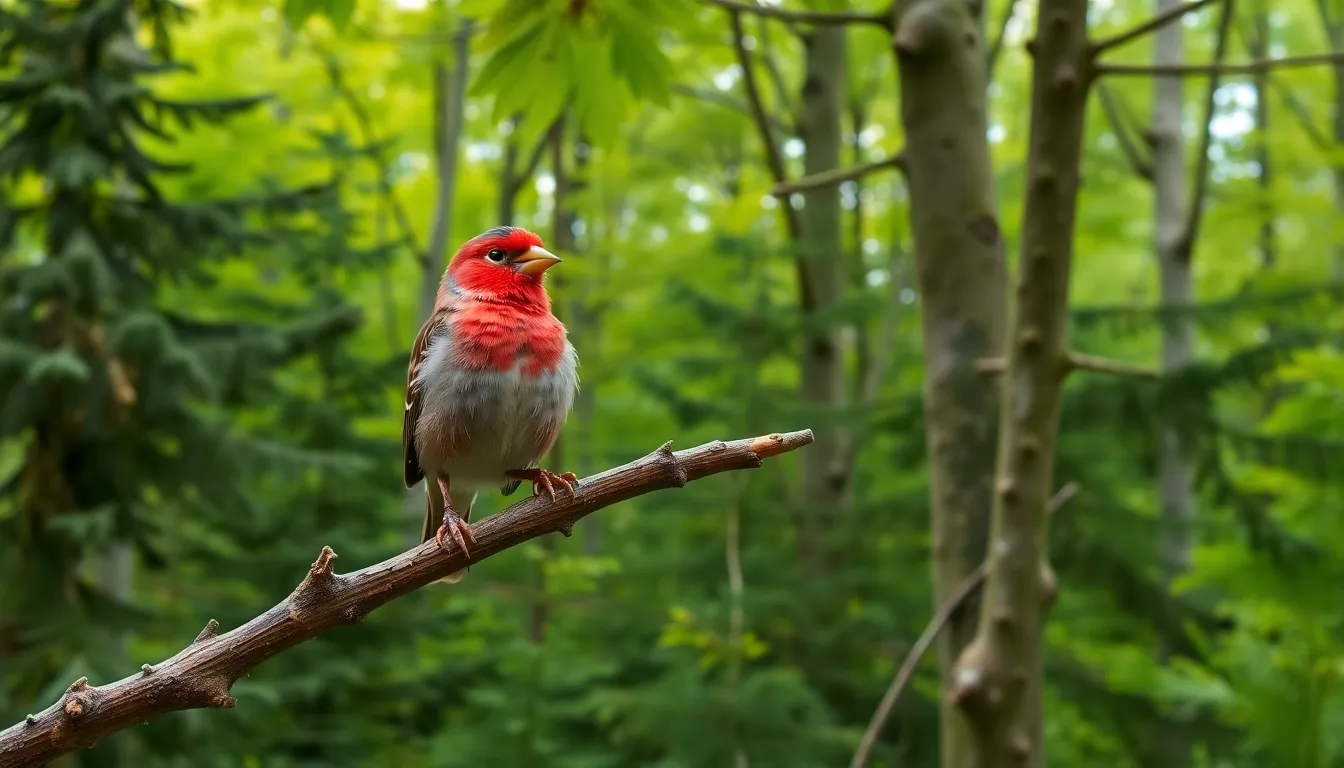
Rosefinch birds occupy diverse territories across three major continents, demonstrating remarkable adaptability to various environmental conditions. Their distribution patterns reflect thousands of years of evolution and migration, creating distinct populations with specialized habitat preferences.
Geographic Range
Common rosefinches establish breeding territories throughout northern Europe and Asia, spanning from Scandinavia to the Pacific coast of Russia. Siberian populations represent the largest concentration of breeding rosefinches, with an estimated 50-100 million pairs during peak breeding season. European populations concentrate in Finland, northern Sweden, and the Baltic states, totaling approximately 2-5 million breeding pairs.
North American rosefinch species occupy different regional zones across the continent. Purple finches inhabit coniferous forests from southeastern Alaska to Newfoundland, extending south through mountainous regions to California and North Carolina. House finches originally populated western North America but expanded eastward after introductions in New York during the 1940s, now occupying territories from coast to coast.
Migration routes connect breeding and wintering grounds across vast distances for many rosefinch populations. Common rosefinches travel 3,000-6,000 miles between Siberian breeding areas and wintering grounds in India, Southeast Asia, and southern China. Stopover sites along these routes include the Caucasus Mountains, Central Asian steppes, and Himalayan foothills.
Preferred Environments
Forest ecosystems provide primary habitat for most rosefinch species, with preferences varying by elevation and tree composition. Coniferous forests at elevations between 3,000-8,000 feet attract purple finches, particularly areas dominated by spruce, fir, and pine trees. Mixed deciduous woodlands containing oak, maple, and birch trees support breeding populations in temperate regions.
Agricultural landscapes offer essential foraging opportunities during migration and winter months. Grain fields, orchards, and farmyard areas provide abundant seed sources, with sunflower and wheat crops representing preferred food plants. Rural gardens and parks create habitat corridors that connect larger forest areas.
Urban environments increasingly support house finch populations, which adapt readily to city conditions. Residential areas with mature trees, bird feeders, and nesting sites accommodate year-round populations. Parks, cemeteries, and landscaped commercial areas expand available habitat within metropolitan regions.
Wetland margins and riparian zones serve as crucial stopover habitats during migration periods. Reed beds, marshes, and streamside vegetation provide shelter and food resources for traveling flocks. These transitional habitats support temporary concentrations of 500-2,000 individuals during peak migration weeks.
Behavior and Lifestyle
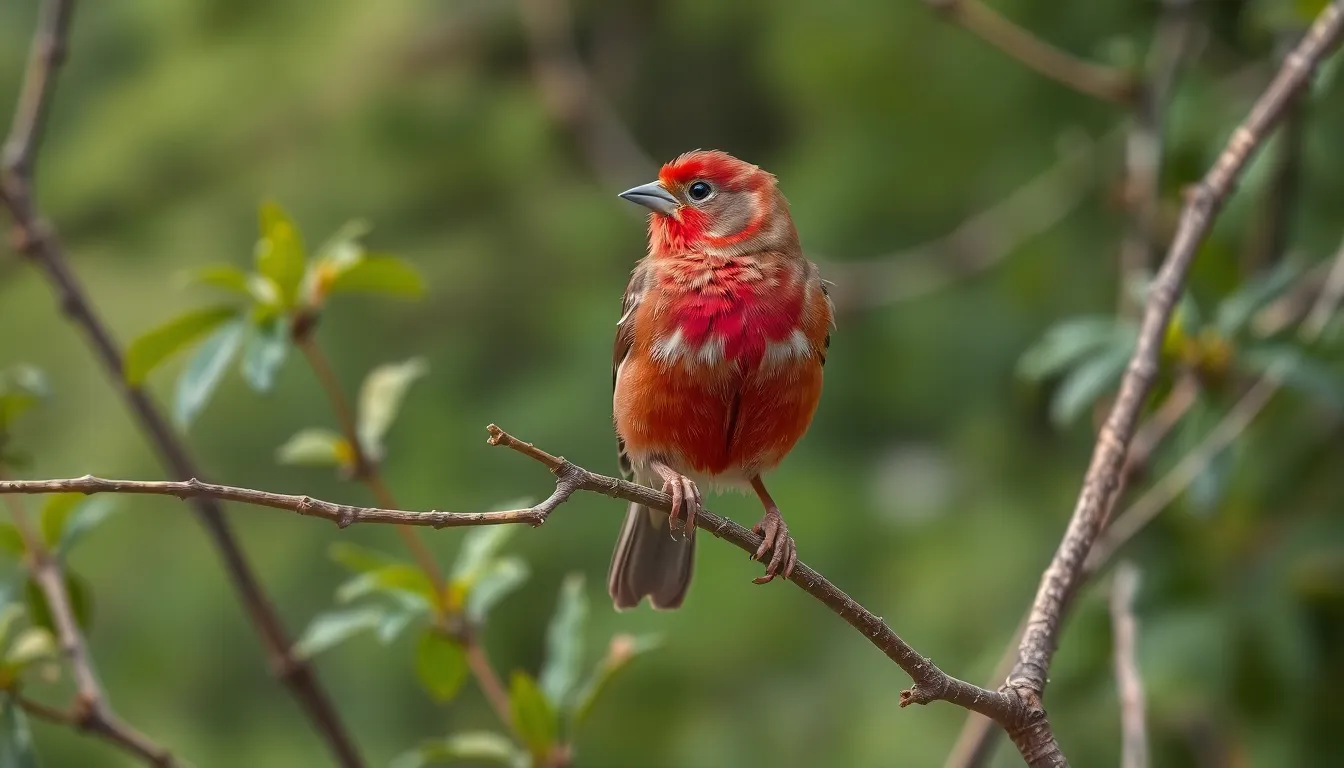
Rosefinches exhibit fascinating behavioral patterns that reflect their adaptability and social nature. These remarkable birds demonstrate complex feeding strategies, intricate social dynamics, and impressive migratory abilities.
Feeding Habits
Rosefinches primarily consume seeds from various plants, making them granivorous specialists with powerful beaks designed for cracking tough seed coats. Common rosefinches prefer seeds from dandelions, thistles, and dock plants during breeding season, while Purple finches favor conifer seeds from spruce, fir, and pine trees. House finches display remarkable dietary flexibility, consuming sunflower seeds, nyjer seeds, and fruit from ornamental plants in urban environments.
Foraging behavior varies significantly between species and seasons. During winter months, rosefinches form mixed feeding flocks with other finch species, systematically searching for food sources across territories spanning 2-5 square miles. Males often forage at different heights than females, with males feeding in tree canopies while females prefer ground level foraging to reduce competition.
Breeding pairs exhibit cooperative feeding behaviors, with males frequently regurgitating seeds to females during courtship and incubation periods. Parent birds collect up to 300 seeds per day when feeding nestlings, making multiple trips between foraging sites and nests located 50-200 meters away.
Social Behavior
Rosefinch social structures change dramatically throughout the year, shifting from territorial pairs during breeding season to gregarious flocks during winter months. Breeding territories typically span 0.5-2 acres, with males defending prime nesting sites through song displays and aggressive posturing toward intruders.
Communication occurs through a complex repertoire of vocalizations including contact calls, alarm calls, and territorial songs. Male rosefinches produce melodic warbling songs lasting 3-8 seconds, with phrases repeated 15-30 times per singing session. Females respond with softer contact calls that maintain pair bonds and coordinate foraging activities.
Flocking behavior intensifies during autumn migration when groups of 20-100 individuals gather at staging areas. These mixed species flocks provide enhanced predator detection and efficient resource location, with experienced adults leading younger birds to productive feeding sites. Dominance hierarchies emerge within flocks, typically favoring older males over females and juveniles when accessing limited food resources.
Migration Patterns
Migration timing varies considerably among rosefinch species, with Common rosefinches undertaking the most extensive journeys covering distances up to 3,000 miles between breeding and wintering grounds. These birds depart northern breeding territories in August and September, following established flyways through central Europe and Asia to reach tropical wintering areas in India, Southeast Asia, and southern China.
Purple finches exhibit irregular migration patterns influenced by food availability, with some populations remaining year round in suitable habitats while others move south during harsh winters. Irruptive movements occur every 2-4 years when conifer seed crops fail, causing massive southward movements of thousands of individuals seeking alternative food sources.
Navigation relies on multiple cues including celestial landmarks, magnetic fields, and geographic features. Young birds learn migration routes by following experienced adults during their first autumn journey, establishing site fidelity to exact wintering areas they return to annually. Spring migration begins in March and April, with birds arriving at breeding territories 2-4 weeks after departure from wintering grounds.
Weather patterns significantly influence migration timing, with favorable tailwinds accelerating travel while storms can delay movements for several days. Staging areas along migration routes provide critical refueling opportunities where birds increase body weight by 20-40% before continuing their journeys.
Breeding and Reproduction
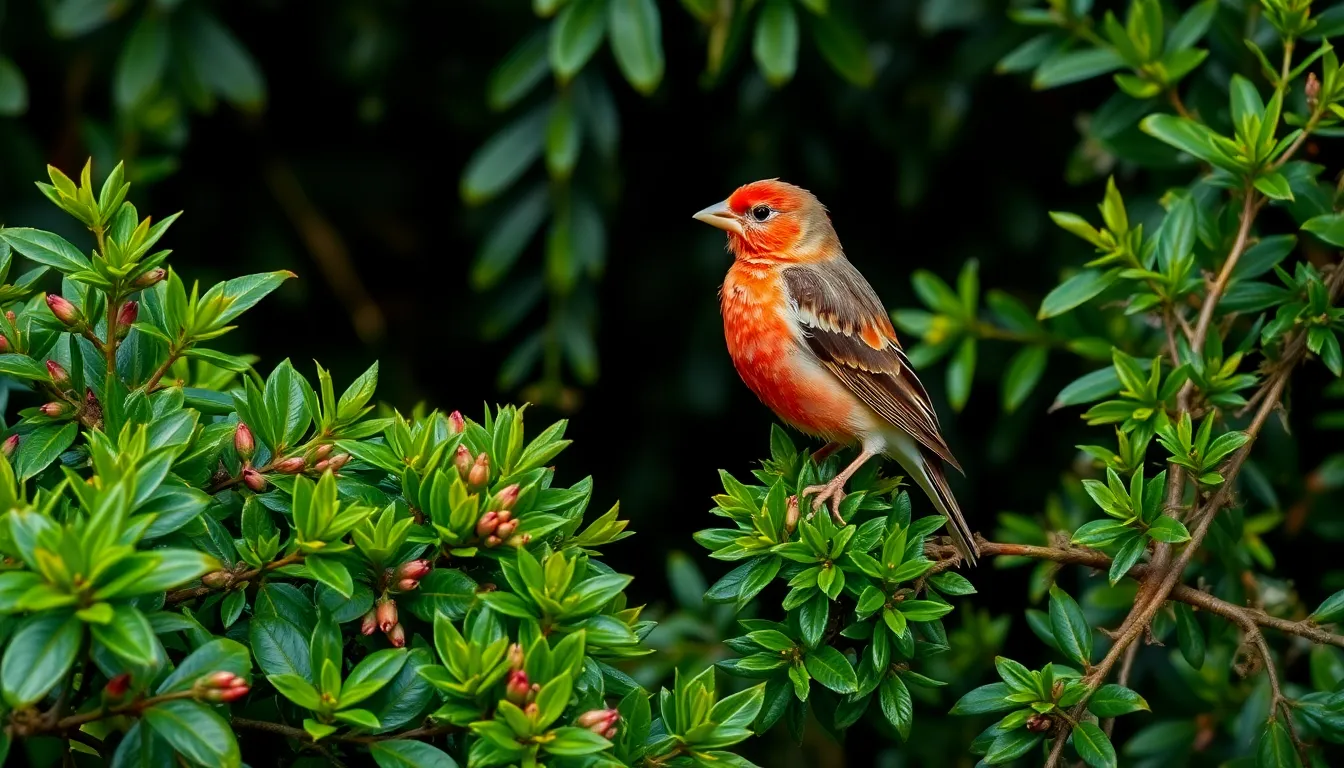
Rosefinch breeding behaviors showcase remarkable adaptability across different climates and environments. These colorful birds demonstrate sophisticated reproductive strategies that ensure species survival in diverse habitats.
Nesting Habits
Common rosefinches construct their nests in dense shrubs and low tree branches, typically positioning them 3-6 feet above ground level. Dense vegetation provides essential protection from predators and harsh weather conditions during the 12-14 day incubation period.
Female rosefinches build cup-shaped nests using twigs, grass stems, and moss, then line the interior with soft materials like animal hair and feathers. Nest construction takes 4-6 days, with females working primarily during early morning hours when temperatures remain cool.
Purple finches prefer coniferous trees for nesting, selecting horizontal branches 5-60 feet high to maximize concealment. Pine, spruce, and fir trees offer ideal nesting sites due to their dense needle coverage and sturdy branch structure.
House finches display exceptional nesting flexibility, utilizing natural cavities, building ledges, hanging planters, and dense shrubs in urban environments. Urban populations often reuse nesting sites across multiple breeding seasons, with some locations hosting successive generations for 3-4 years.
Nest dimensions vary by species, with common rosefinches building structures measuring 4-5 inches in diameter and 2-3 inches deep. Material selection depends on local availability, though all species prioritize soft lining materials for egg protection and chick comfort.
Mating Season
Rosefinch mating seasons align with peak food availability and favorable weather conditions across their geographic ranges. Common rosefinches begin courtship activities in late April through early June in northern breeding territories.
Males establish territories covering 0.5-2 acres through persistent singing and aggressive displays toward rival males. Territory quality directly correlates with male reproductive success, with prime locations offering abundant seed sources and suitable nesting sites.
Courtship displays feature elaborate performances where males showcase their vibrant plumage while singing melodic sequences lasting 15-30 seconds. Males often present food offerings to prospective mates, demonstrating their foraging abilities and commitment to pair bonding.
Purple finches extend their breeding season from May through August, allowing for 2-3 successful broods in favorable conditions. Extended breeding periods enable these birds to capitalize on abundant conifer seed crops during peak growing seasons.
House finches breed year round in temperate climates, with peak activity occurring March through August. Urban environments provide consistent food sources and nesting opportunities that support extended reproductive periods.
Female rosefinches lay 3-6 eggs per clutch, with egg coloration ranging from pale blue to greenish white with brown speckles. Incubation duties fall exclusively to females, though males provide regular food deliveries throughout the brooding period.
Breeding success rates average 65-75% across rosefinch species, with predation and weather representing primary threats to nesting attempts. Successful pairs often produce 2-3 broods annually when environmental conditions permit extended breeding seasons.
Conservation Status and Threats
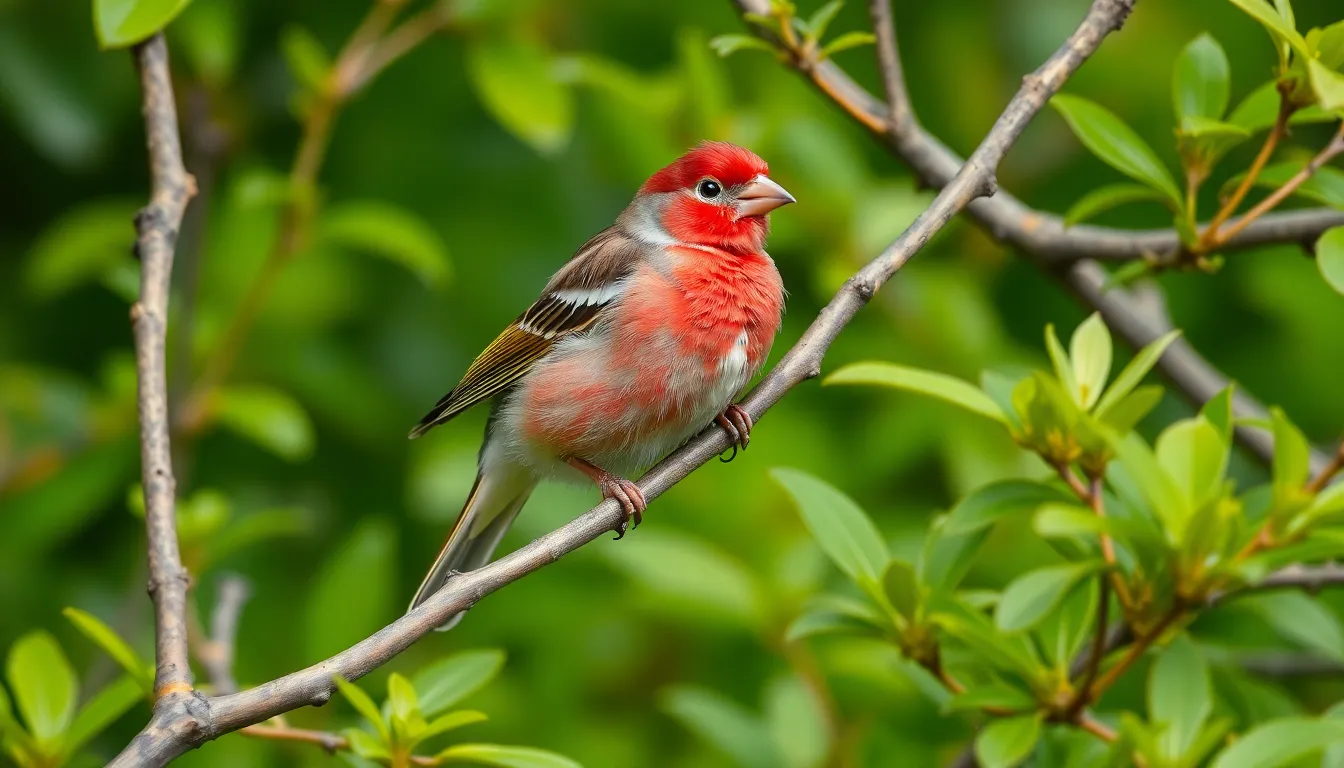
Rosefinch populations face varying levels of conservation challenges across their global range. The IUCN Red List classifies most rosefinch species as “Least Concern,” though exact regional populations show declining trends that warrant monitoring.
Population Status by Species
| Species | IUCN Status | Population Trend | Estimated Numbers |
|---|---|---|---|
| Common Rosefinch | Least Concern | Declining | 15-40 million pairs |
| Purple Finch | Least Concern | Stable | 4-6 million individuals |
| House Finch | Least Concern | Increasing | 21-40 million individuals |
| Scarlet Rosefinch | Near Threatened | Declining | 200,000-500,000 pairs |
Climate change represents the most important long-term threat to rosefinch populations. Rising temperatures alter breeding ranges, forcing species like the Common Rosefinch to shift northward by approximately 65 kilometers per decade. Mountain-dwelling species face particular vulnerability as suitable habitat shrinks at higher elevations.
Habitat destruction through deforestation affects 23% of rosefinch breeding territories annually. Agricultural intensification eliminates native seed sources, reducing available food by up to 40% in traditional wintering grounds. Urban development fragments forests, creating barriers that disrupt migration corridors spanning thousands of miles.
Pesticide contamination impacts rosefinch reproduction through reduced clutch sizes and lower hatching success rates. Neonicotinoid pesticides decrease breeding success by 15-25% in agricultural areas. Herbicide use eliminates wildflower seeds that comprise 60% of the rosefinch diet during winter months.
Invasive species compete directly with native rosefinches for resources. European Starlings occupy nesting cavities in North America, reducing available sites by 30% in some regions. Invasive plant species replace native seed producers, forcing dietary adaptations that may not provide adequate nutrition.
Regional Conservation Concerns
Northern European Common Rosefinch populations declined 37% between 2000 and 2020. Scandinavian breeding pairs dropped from 2.5 million to 1.6 million during this period. Warmer springs disrupt synchronized breeding with peak insect abundance, affecting chick survival rates.
Asian rosefinch subspecies encounter unique pressures from rapid industrialization. Mining operations destroy alpine meadow habitats where specialized seeds grow. Air pollution reduces visibility during migration, increasing collision rates with structures by 18%.
North American Purple Finch numbers fluctuate with coniferous forest health. Bark beetle infestations kill mature spruce trees, eliminating preferred nesting sites. Forest management practices that remove dead trees further reduce available habitat.
Conservation Efforts and Success Stories
Habitat restoration projects show promising results across rosefinch ranges. Reforestation initiatives in Scotland increased Common Rosefinch breeding pairs by 45% over eight years. Native plant restoration programs provide essential seed sources during critical migration periods.
Agricultural conservation programs benefit rosefinch populations through wildlife-friendly farming practices. Buffer strips along field edges support native plants that produce seeds eaten by wintering flocks. Reduced pesticide application in participating farms correlates with 20% higher rosefinch abundance.
Citizen science monitoring contributes valuable population data through programs like eBird and Christmas Bird Counts. Over 50,000 volunteers submit rosefinch observations annually, creating comprehensive distribution maps that guide conservation priorities.
International cooperation addresses migratory species protection through treaties covering flyway habitats. The East Asian-Australasian Flyway Partnership protects stopover sites used by millions of rosefinches during seasonal movements.
Future Conservation Priorities
Protected area expansion targets key breeding and wintering habitats across rosefinch ranges. Proposed reserves in Central Asia cover 12,000 square kilometers of critical alpine habitat. Connectivity corridors between existing parks maintain genetic diversity among isolated populations.
Research initiatives focus on understanding climate adaptation mechanisms in rosefinch species. Genetic studies identify populations with heat tolerance traits that may persist as temperatures rise. Breeding programs maintain captive populations of vulnerable subspecies as insurance against extinction.
Community engagement programs educate local populations about rosefinch conservation needs. School education initiatives in rural areas promote habitat-friendly practices among future landowners. Ecotourism development provides economic incentives for protecting rosefinch habitats while supporting local communities.
Rosefinch Bird Watching Tips
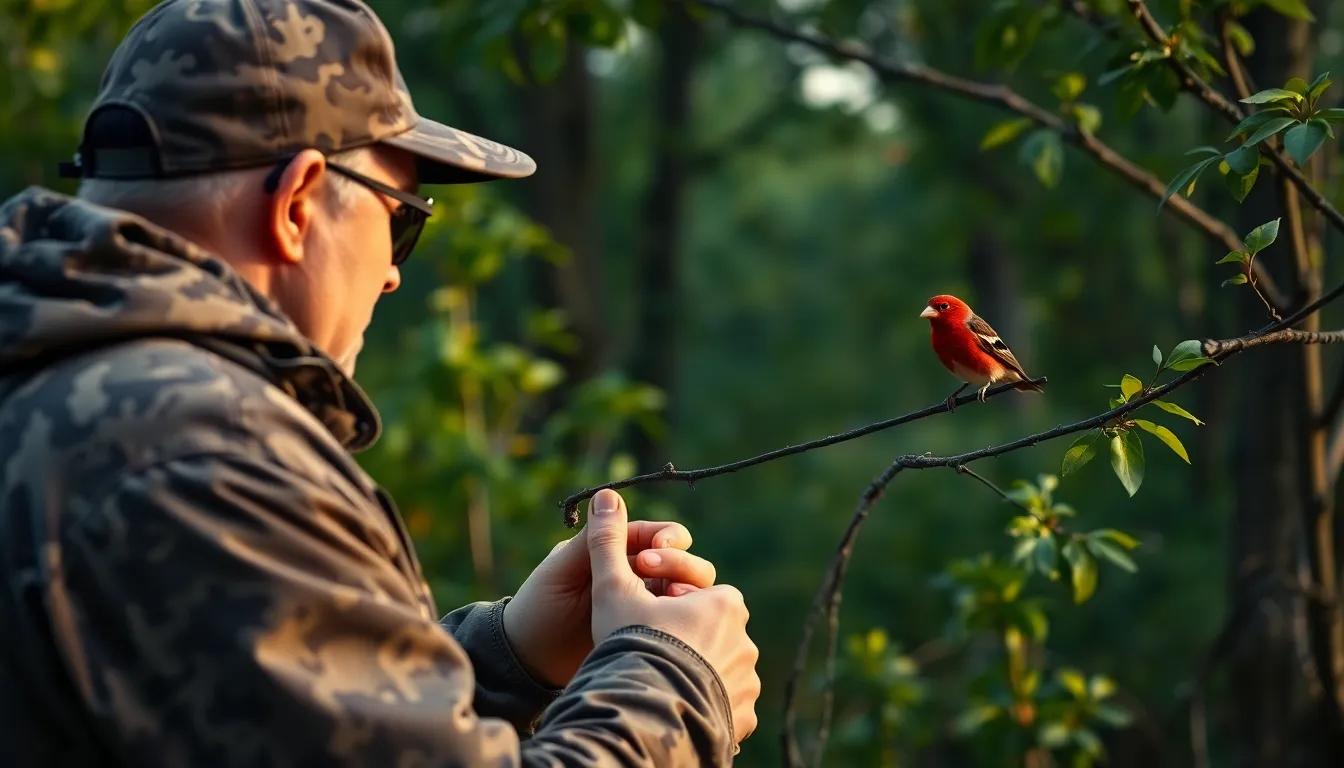
Rosefinch bird watching requires strategic timing and proper techniques to maximize your chances of spotting these colorful finches. Successful observation depends on understanding their seasonal patterns and using appropriate equipment for different viewing conditions.
Best Times to Spot Them
Dawn and dusk provide optimal rosefinch viewing opportunities when these birds are most active in their feeding routines. Common rosefinches appear between 5:30-7:30 AM during spring migration from April through May across European and Asian territories. Purple finches concentrate their activity around dawn feeding sessions in coniferous forests throughout North America from March to October.
Winter months from December to February offer excellent House Finch observations at backyard feeders and urban parks during midday hours when temperatures peak. Migration periods create concentrated viewing windows with Common rosefinches passing through stopover sites for 3-7 days in September and October. Breeding season observations work best during early morning hours from May through July when males perform territorial displays and courtship behaviors.
Weather conditions significantly impact rosefinch visibility patterns across different species and regions. Clear mornings after rain storms bring increased activity as birds resume foraging after weather delays. Overcast days with light winds create ideal conditions for extended observation periods without harsh lighting challenges.
Equipment and Techniques
Binoculars with 8×42 magnification provide the optimal balance between image stability and field of view for rosefinch identification in various habitats. Spotting scopes with 20-60x zoom capability enhance long distance observations in open agricultural areas and wetland margins where rosefinches forage during migration. Camera equipment featuring 300-500mm telephoto lenses captures detailed images of male rosefinches displaying their characteristic rosy pink plumage during breeding season.
Field guides exact to your regional rosefinch species improve identification accuracy when distinguishing between Purple Finches and House Finches in North American locations. Audio playback equipment using recorded rosefinch songs attracts territorial males during breeding season from May through July. Smartphone apps with bird call libraries help identify different rosefinch vocalizations including contact calls and alarm notes.
Positioning techniques maximize rosefinch observation success across diverse viewing environments. Habitat edges between forests and open areas concentrate rosefinch activity during feeding periods throughout the day. Water sources including streams and birdbaths attract multiple rosefinch species for drinking and bathing behaviors. Seed rich areas near agricultural fields and weedy patches draw foraging flocks during autumn and winter months.
Patience and stillness prove essential when observing wary rosefinch species in their natural habitats. Movement minimization prevents flight responses that disrupt extended observation sessions. Camouflaged clothing helps blend into forest environments where Purple Finches nest in coniferous trees. Early arrival at known rosefinch locations establishes viewing positions before peak activity periods begin.
Conclusion
We’ve explored the remarkable industry of rosefinches and discovered why these vibrant birds captivate nature enthusiasts worldwide. Their adaptability across diverse habitats from Arctic tundra to urban landscapes demonstrates nature’s incredible resilience.
As we face environmental challenges these beautiful finches remind us of our responsibility to protect their habitats. Supporting conservation efforts and participating in citizen science programs helps ensure future generations can witness their stunning displays.
Whether you’re a seasoned birder or just beginning your journey we encourage you to venture out and experience these magnificent creatures firsthand. The rosefinch’s melodic songs and brilliant plumage offer rewards that make every observation memorable.
Frequently Asked Questions
What is a rosefinch and what makes it special?
A rosefinch is a colorful bird belonging to the finch family Fringillidae, known for its vibrant pink and red plumage. These birds measure 5-7 inches in length and are popular among birdwatchers due to their striking appearance, fascinating behaviors, and adaptability. The genus Carpodacus includes around 28 species distributed across Europe, Asia, and North America.
How can I tell the difference between male and female rosefinches?
Male rosefinches display vibrant rosy-pink or red plumage during breeding season, with color intensity indicating age and health. Females sport muted brown and gray tones for camouflage while nesting. Juvenile rosefinches resemble females until males develop their characteristic bright colors in their first breeding season.
What are the main types of rosefinch species?
The three primary rosefinch varieties are the Common Rosefinch (most widespread, breeding in northern Europe and Asia), Purple Finch (inhabits North America’s coniferous forests), and House Finch (highly adaptable to urban environments). Each species has unique nesting habits, diets, and social behaviors suited to their specific habitats.
Where do rosefinches live and what habitats do they prefer?
Rosefinches inhabit diverse environments from Arctic tundra to temperate forests across Europe, Asia, and North America. They thrive in forest ecosystems, agricultural landscapes, urban areas, and wetland margins. Their remarkable adaptability allows them to successfully live in various conditions, from wilderness to city environments.
What do rosefinches eat and how do they behave?
Rosefinches primarily consume seeds, with different species showing varied dietary preferences. They possess sturdy, cone-shaped beaks perfect for seed cracking. These social birds form mixed feeding flocks in winter and display cooperative feeding during breeding season. They communicate through melodic songs and perform courtship displays.
Do rosefinches migrate and how far do they travel?
Migration patterns vary by species. Common rosefinches undertake extensive journeys up to 3,000 miles from breeding grounds to tropical wintering areas. Purple finches show irregular migration influenced by food availability, while House finches are generally non-migratory. They navigate using celestial cues and geographic features.
How do rosefinches breed and raise their young?
Rosefinches adapt their breeding behaviors to different climates. Females lay 3-6 eggs per clutch in nests built in various locations: Common rosefinches use dense shrubs, Purple finches prefer coniferous trees, and House finches utilize urban structures. Breeding success rates average 65-75%, with males establishing territories through song.
Are rosefinches endangered or threatened?
Most rosefinch species are classified as “Least Concern” by the IUCN, though some like the Scarlet Rosefinch are “Near Threatened.” They face threats from climate change, habitat destruction, pesticide use, and competition from invasive species. Regional population declines have been noted in Northern Europe and Asia.
What conservation efforts are helping rosefinches?
Conservation efforts include habitat restoration projects, agricultural programs benefiting rosefinch populations, and citizen science initiatives for monitoring. International cooperation is vital for protecting these migratory birds. Future priorities focus on expanding protected areas, researching climate adaptation, and engaging local communities in conservation efforts.
When and how can I best observe rosefinches?
Optimal viewing times are dawn and dusk when rosefinches are most active. Use binoculars or spotting scopes for identification, along with field guides and audio playback devices. Position yourself near water sources, minimize movement, and visit during migration periods for the best chances of spotting these beautiful birds.

